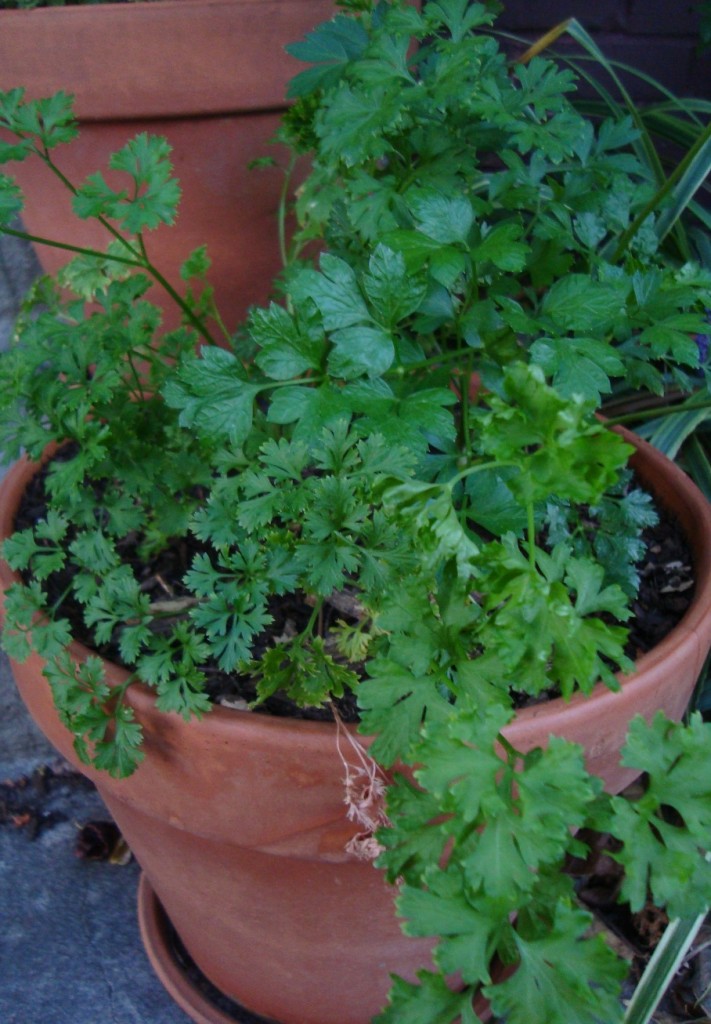This week we continue our herb odyssey. And now, make way for… (fanfare!!!) Ms. Parsley!
“Uncle Alber had always been somewhat of a wonder-character in our family… When he moved to the lone farmhouse, we thought he would break in a week or two, but he surprised us all. He lived alone, made his own living and even found time for hobbies – he grew poems by Francis Jammes. In the parsley beds he lovingly pruned beautiful letters, words and lines. When we visited, we always found a new poem in every bed, glimmering in modest green, and beside it, with sweat-flowing temples, Uncle Alber, glowing like a sleepy saint…”
(From: “Uncle Alber” In Beach Manors)
So parsley is a great poem-writing tool, maybe specifically poems by Francis Jammes. On one hand, for us parsley is natural, everyday and very familiar, and we nonchalantly sprinkle it over salads or garnish soups. Yet in Western culture, parsley is actually associated with such heavy-duty issues as life and death, wars and victories, and romance and heartbreak.
Parsley’s been here in the Mediterranean for many years, originating in southern Europe and the Mediterranean Basin, and first mentioned in ancient Greek lore. The Greeks wore garlands of parsley to celebrate victory, and would scatter parsley leaves upon gravestones. They are also the ones who gave its name, attempting to differentiate between parsley and its cousin, the celery. The title petroselinum means “rock celery,” as opposed to heleioselinon, “marsh celery” (regular celery), which grows near water sources. Perhaps because it was a holy symbol of victory and death, Greeks never served parsley as food!
The first to actually use parsley in cooking are the Romans, but parsley owes its culinary victory to Italian princess Catherine de’Medici, who married a Frenchman but refused to leave home without her Italian spices. From there, it was a short and tasty path towards parsley’s obligatory presence in every kitchen in the area.
Leaf parsley, as opposed to that grown for its thick root, has two types of leaves: flat or curly. Curly leaf parsley is often used as a garnish. The flat leaf is the more common variety, used in cooking for its rich content of the essential oil apiol, which gives it a stronger taste.
In Greek mythology, parsley is connected to the story of baby Archemorus, son of the Nemean king Lycurgus, who was left alone by his nursemaid and bitten to death by a snake. When the nurse lifted the dead child, she found a parsley bush beneath, which legend said grew from the boy’s blood. In his memory, the Greeks established the Nemenean Games in which a eulogy was recited in memory of the dead child, and the winners were crowned with garlands of parsley. Thus parsley became a sacred plant associated with honoring the memory of the dead. In the same context, parsley was dedicated to Persephone, queen of the underworld, who spends autumn and winter in the underworld and surfaces in springtime, spurring blossoming and renewal. Another underworld creature linked to parsley is Charon, ferryman of Hades, who ferried souls of the newly-deceased across the River Acheron that divided between the worlds of the living and the dead. To encourage him to take the dead to the hereafter, it was customary to use parsley at funerals and bury it near the grave.
And in an altogether different function: Children on the Island of Guernsey in the Channel Islands who ask where babies come from are told that they’re dug out of the parsley patch by golden rakes. Parsley arrangements adorned festive tables in Greece and Rome. Wearing a parsley strand was considered helpful for freshening bad breath (even garlic breath), eliminating the scent of wine and for sobering up the intoxicated.
In one of his tales, Greek biographer Plutarch tells about the life of Timoleon, a Sicilian warrior from the town of Corinth, who set out to protect the city of Syracuse against the invading Carthaginians surrounding the city from the west. Timoleon was only able to muster 3,000 soldiers to face an army ten times their might. When they climbed the hill to observe the Carthaginians, they encountered a convoy of oxen laden with parsley. The frightened soldiers saw this as cause for alarm, but Timoleon delivered an impassioned speech in which he proclaimed that the gods had sent them their victory crowns. Immediately, he made himself a crown of parsley, and his officers followed suit. Sure enough, the Sicilians braved the invaders, thanks to their skill and the patronage of a sudden rainstorm that blocked the armored and cumbersome Carthaginians.
Since she has been in this region for a good while and seen empires rise and fall, seasons change, and stars be born and die, Ms. Parsley has all the time in the world. She sprouts very slowly. In cold temperatures, this can take forever. Sometimes we’re almost dismayed when a month goes by with no sign of parsley, but just then, as we’re ready to give up, soft green shoots suddenly emerge. And as soon as it sprouts, it’s here to stay. Parsley survives heat and cold, sun and partial shade, continuing to grow green leaves even after many harvests – alive and kicking long after the coriander and dill go to flower and seed. In contrast to annual plants, she is a biennial, sticking around for two years before blooming and seeding.
Parsley has always been popular in home gardens and in window boxes. Different reasons have been attributed to parsley’s growth pattern, perhaps because the seeds sprout so slowly. In cold England, the belief is that parsley seeds pay a few visits to Satan and back before they can sprout. This is why sprouting parsley seeds under glass is a good idea in cold weather, since it warms the ground and perhaps halts a visit to the underworld.
According to one ancient belief, parsley only grows in homes where the woman is dominant. Or there are others who claim that parsley only grows for witches and cruel women (dominant or not)… Plus, if your parsley has already sprouted and grown, don’t dare dig it out, as this will bring bad luck. Or – if you give someone your parsley, you give away your luck as well. So next time you move, try to find an apartment with a window box that holds parsley.

But aside from matters of luck, parsley is good for us. The first proof of this comes from my husband’s favorite childhood book, The Tale of Peter Rabbit, with the story of hungry Peter Rabbit, a farmer’s nightmare: “First he ate some lettuce and some broad beans, then some radishes, and then, feeling rather sick, he went to look for some parsley.”
As a veteran of the Western world, parsley is known as a rich source of a host of vitamins and minerals, including vitamin C (three times more than citrus!), folic acid, beta-carotene, pro-vitamin A, potassium and magnesium. But lately it’s been glorified yet again, this time by the Asians: Japanese research has recently discovered a new vitamin, pyrroloquinoline quinine (or PQQ). The previous new vitamin was discovered in 1948! PQQ, which is most likely connected to the vitamin B group, is involved in encouraging fertility, and researchers believe it has other health advantages as well. Good sources of PQQ are parsley, green tea, green pepper, papaya, nato (fermented soybeans) and kiwi.
Herbs in the Umbelliferae family–including parsley–contain phytochemicals, many of which have cancer-preventing attributes. These phytochemicals block hormonal activity that is linked to the development of cancer. Throughout history, parsley has been used to treat a variety of medicinal problems. It seems to be the ultimate magic potent: drinking a parsley brew is good for treating indigestion, urinary tract infections and kidney diseases. For swollen eyes, it’s best to use a compress of brewed parsley liquid. Parsley helps lower both cholesterol and blood pressure; it prevents the formation of blood clots and protects against heart disease and arteriosclerosis. Parsley eases menstrual pain and can be used externally for skin problems. In addition, parsley bolsters the immune system, acts as an antiseptic, helps purify the body of toxins and is good for preventing water retention, including edema. Parsley is helpful in preventing dysentery and is beneficial for the lungs, stomach, liver and thyroid. However, pregnant women and nursing mothers are cautioned against consuming large quantities of parsley or using parsley liquid, for it can stimulate the uterus and dry up the milk. (We’re discussing large, medicinal quantities, not small pinches…)
Tips:
- Store parsley wrapped in paper in a plastic bag, refrigerated. The paper will absorb the excess moisture, and the plastic bag will keep it from over-drying.
- Parsley loses vitamins in the cooking process.
- In order to coax the most taste and nutrients from parsley, add it only at the final stages of cooking or sprinkle fresh over prepared food.
- Chewing parsley leaves after eating garlic eliminates the garlic smell from your breath (replacing it with parsley-breath…)
See our Recipe Corner for two great parsley dishes, where she’s not just a garnish, but is the true star! Parsley Latkes and Parsley Cake: עוגת פטרוזיליה לביבות פטרוזיליה
Wishing everyone a week filled with all the goodness of parsley: Life, good health, family, fortune and happiness!
Alon, Bat-Ami, Dror and the entire Chubeza team, living it up in the sunny days after the plentiful weekend rain
_____________________________
WHAT’S IN THIS WEEK’S BOXES?
Monday: Swiss chard/totsoi, lettuce, slice of pumpkin/broccoli, cauliflower/Jerusalem artichokes, cucumbers, tomatoes, daikon/baby radishes, beets/fennel/turnips, coriander/parsley, carrots, sweet potatoes. Special gift: arugula/red mizuna.
Large box, in addition: Eggplant/cabbage/lubia Thai yard-long beans, scallions/celery, kale/winter spinach.
FRUIT BOXES: Bananas, red apples, avocado, oranges/pomelit, clementinas.
Wednesday: Swiss chard/totsoi, lettuce, slice of pumpkin/eggplant/cabbage/lubia Thai yard-long beans, broccoli/Jerusalem artichokes, cucumbers, tomatoes, daikon/baby radishes/fennel/turnips, beets, coriander/parsley/dill, carrots, sweet potatoes. Special gift: arugula/red mizuna.
Large box, in addition: Cabbage/cauliflower, scallions/celery, kale/winter spinach.
FRUIT BOXES: Bananas, red apples/kiwi, avocado, oranges/pomelit, clementinas.


